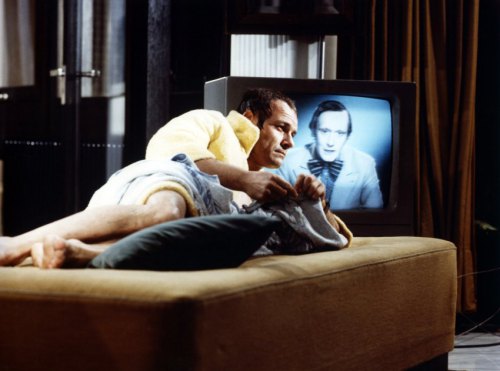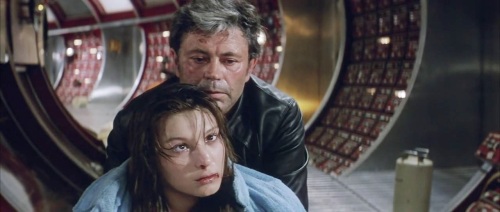
.
By Roderick Heath
.
The title resolves amidst intersecting geometries that coalesce and create a cityscape, ranged with neo-Babylonian techno-ziggurats: Metropolis, instantly a statement worthy of Ozymandias. A super-city where trains and cars shuttle along spanning bridges and aircraft buzz between sky-nudging structures. A great machine that explodes and morphs into a dark god of ages past, accepting human sacrifice into a greedy, fiery maw. A great dial of switches becomes a massive clock crushing its operator. A dark and twisted fairytale abode left like a seed of corruption in the midst of this empire of the will. The outpost of an ancient brand of faith discovered underground, to where the beaten and exhausted tread in search of hope. A beam of light in the midst of a dank, labyrinthine catacomb, terrorising and pinioning a saintly young woman. A robot fashioned in the likeness of a human, all art-deco brass curves and blank features, wreathed by electric arcs, slowly taking on the likeness of the same young woman. The robotic simulacrum dancing like Salome reborn, stirring the lusts of men until their eyes join together in a great mass of rapacious gazing. Statues of the seven deadly sins lurching out of their stalls in a Gothic cathedral, announcing the coming of calamity and death. A mass of desperate children all reaching out for their saviours in the midst of surging flood waters. A rooftop struggle between hero and villain for the life of the heroine, the battle of good and evil staged as vertiginous graph written on the face of a civilisation.
.

.
These are some of the lodestone images of Fritz Lang’s Metropolis, and it’s still easy to feel their power even after intervening decades where their genetic material is woven into pop culture at large. If A Trip to the Moon was the seed of science fiction on screen, Metropolis is its green stem, and much more too. The floodtide of Fritz Lang’s visual techniques and the expanse of the film’s evocation of the future might have met resistance of mind and eye in its day, but even in an abused and truncated form enough of his vision remained to stun the eye and light the creative spark.
.

.
(more…)
Archive for the ‘science-fiction countdown’ Category
3. Stalker (1979)
Posted in Lee Price's Film Reviews, science-fiction countdown on October 17, 2016| 6 Comments »

by Lee Price
In Andrei Tarkovsky’s Stalker (1979), there’s the ordinary world where the Stalker lives with his wife and daughter, there’s a border area patrolled by the military, there’s a sealed-off forbidden area known as the Zone, and, legend says, there’s a room inside the Zone where one’s deepest wishes may be granted. Picture it as concentric circles—a mandala radiating outward from the mysterious room at its spiritual center. In both the movie Stalker and its source book Roadside Picnic by Arkady and Boris Strugatsky, the term Stalker refers to the guides who illegally escort guests into the Zone.
Stalker’s Zone is perhaps the most stripped-down version ever of a very familiar place.
In The Wizard of Oz (1939), Dorothy Gale crossed the boundary between black-and-white and Technicolor, and then followed the Yellow Brick Road deep into the Zone, led by the Stalker team of Scarecrow, Tin Man, and Cowardly Lion. Although some dismiss the account as nothing more than a dream, some say she reached and entered the Room, achieving the core desire that was in her heart all along.
In The Lord of the Rings, both book and films, Frodo Baggins is mentored by Gandalf, the Grey Stalker, who instructs Frodo on how to pass through the Zone in order to return a purloined heirloom to the Room.
In 2001: A Space Odyssey (1968), a film notoriously rejected as “phony” by Tarkovsky, Dr. Dave Bowman journeys through an expansive psychedelic Zone with a (what else?) Room at its center. (more…)
4. Blade Runner (1982)
Posted in J.D.'s film reviews, science-fiction countdown on October 16, 2016| 10 Comments »

By J.D. Lafrance
“It’s just like everything that is awful about the city, but at the same time, everything that is fascinating about it…and this, in many ways, is a futurist projection—it’s not so much escapist, it’s a projection of what life will be like in every major metropolis 40 years from now.” – Philip K. Dick, 1982
Big Brother is watching you. The Eye in the Sky. There Are Eyes Everywhere. 2016…or 2019? In this day and age, does three years matter? In 1982, however, the difference was cavernous and 2019 a lifetime away. The past has finally caught up with the present…or has the present finally caught up with the past? One of the first images shown in Blade Runner (1982): an extreme close-up of an eye – encapsulates all of this, for we are living in paranoid times. We are living in Philip K. Dick’s world. This film was based on his 1968 novel, Do Androids Dream of Electric Sheep? He has become one of the most widely-adapted science fiction authors and with good reason. He crafted paranoid tales populated by damaged characters trying to figure out what it means to be human. What were once considered paranoid delusions have become tactile realities.
(more…)
9. Frankenstein (1931)
Posted in Robert Hornak's film reviews, science-fiction countdown, Uncategorized on October 11, 2016| 11 Comments »

by Robert Hornak
Mary Shelley’s original novel was born in the long wake of the western world’s great unshackling from regal tyranny. The American and French Revolutions were still visible in the rear view mirror, being free was the lingua franca of the day, and by the early 1800s, a de facto requirement for progress and individual happiness. Meanwhile, Shelley’s own mother had been a force for gender equality, working to break women away from the tyranny of male power structures. It’s no wonder that Mary, whose blood must have pumped with the assumptions of freedom, would push her imagination into the ultimate realm of tyranny, death itself. Her impromptu story that fateful stormy night in Switzerland, having first captured the imagination of the small group of literary souls that surrounded her that weekend, has grown tall, unconquerable, and endlessly re-built into a myriad combinations from horrifying to hilarious. It’s immediate popularity spread even further in play form, needfully limiting the scope of the novel, and adding elements – like, eventually, the right-hand lab assistant – that might help keep the stage-bound version as captivating as was her globe-trotting tale of a man and his philosophically-minded creation. By the age of film, the story was already ubiquitous, and generally known as much from its ancillary versions as its original incarnation. Thus, by 1931, the ground was ready for the tilling, and Universal, seeking to recapture Dracula‘s lightning in a bottle, leapt upon Shelley’s story, setting it before a new audience, one for whom the bright optimism of the Enlightenment had long since been dimmed by the most bloody, spirit-rending war the world had ever seen, the dark memories of which moved alongside the despair pulsing up out of a brand new, worldwide economic catastrophe. It was tyranny of another kind, a spiritual and psychological one, as well as economic, and all steeped in the relative newness of Freudian self-awareness. Man, whose 19th century take-away was that science, not God, would rescue them, had crawled through the mud of war and poverty to conclude that not only would God not rescue them, but that God wasn’t even there, and that it was time for the great human DIY project. In this spirit, director James Whale framed his version in pitch-black bolts of shadow and delivered the ultimate story of man-as-God to a world that could now embrace the creature rescued from death in the mold of these new, early 20th century tyrannical shackles, and would watch him burst forth into the new world – a place where the chance to live forever could be crushed by the ever-adapting forces of hate and fear. (more…)
10. World on a Wire (1973)
Posted in science-fiction countdown on October 10, 2016| 2 Comments »

by Bob Clark
There’s an interior-decorating philosophy that espouses the idea of using mirrors to make a small room look bigger. I don’t know if it’s related to fung shui, or perhaps just a very basic recognition of the power of duplicated imagery, but there’s something about it that can work rather well, and at times even do wonders. With one mirror, the horizon of a single room can extend just a little farther, and open things up just enough to stave off unconscious feelings of claustrophobia in the mind’s eye, if not in the actual ones for very long. Place another one in the room with it at an angle, and things open up even more, allowing you to curve space subtly with reflected reflections, building a new and artificial kind of architecture through the location’s subliminal atmosphere. Finally, put a pair of mirrors directly across from one another and you have that classic barber-shop parlour trick of infinitely extending reflections receding into both directions, that little feat of magic that Orson Welles put to such good use near the end of Citizen Kane and Carl Sagan used to similarly impressive import in one of the later episodes ofCosmos, expressing the inherently evasive concept of eternity itself.
Plenty of filmmakers and artists have exploited this potential for mirrors as instruments of mind-bending challenges of time, space and pure mathematics– some ten years ago I can remember a recreation of a Yayoi Kusama installation, full of polka-dotted rock formations extended in all directions by an entirely mirrored room, while strolling through a retrospective of her work at the Museum of Modern Art. Recently I had another encounter with the mirrored-lens visions of uber-reflective expression at MoMA while catching a rare screening of a newly remasteredWorld on a Wire by Rainer Werner Fassbinder, a work which has long gone unseen since its original broadcast as a two-part miniseries for German television in 1973, and expands the famously bold director’s body of work to include science-fiction alongside all the old familiar places of Douglas Sirk melodrama and World War II era expressionist musicals. But not only does this film show Fassbinder’s take on sci-fi– it also manages to tell one of the first cinematic depictions of virtual-reality, long before the likes of Tron, The Matrix or Inception, and with a surprisingly dexterous hand, especially when it comes to presenting various layers of simulations. (more…)






























 Click on names for archives
Writers/Founders
Click on names for archives
Writers/Founders